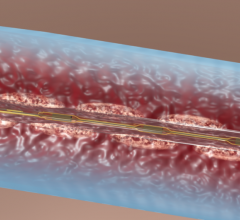March 7, 2011 – Each year between 100,000 and 180,000 Americans die as the result of pulmonary embolism, a complication from blood clots in the lungs. The Vascular Disease Foundation urges Americans, especially women, to learn about the risks of venous blood clots to help prevent these deaths.
While men and women are at equal risk, the risk for deep vein thrombosis (DVT) varies depending on where a woman is in her lifecycle, her hormone levels and if she has a family history of clotting disorders.
DVT occurs when a blood clot forms in the deep veins, usually of the pelvis or leg. It can be fatal if a clot breaks free from the leg veins and travels through the heart and lodges in the lung arteries. This complication, called pulmonary embolism (PE), causes between 100,000 and 180,000 deaths per year in the United States. Also, because blood clots can permanently damage the veins, DVT survivors can experience long-term leg pain, heaviness and swelling. This can progress to difficulty in walking, changes in skin color and open leg ulcers. This condition, called post-thrombotic syndrome (PTS) or "chronic venous insufficiency," can significantly impair quality of life.
Risk factors or triggering events that are more likely to affect women include pregnancy and the six to eight weeks after giving birth, the use of birth control pills or postmenopausal hormone replacement therapy, cancer and its treatment, and major surgery.
Anyone may be at risk for DVT, but the more risk factors a person has, the greater their chances are of developing it. Knowing the risk factors gives patients the chance to do something about it. Risk factors include:
• Hospitalization
• Recent major surgery (especially orthopedic surgery), injury or trauma
• Personal history of a clotting disorder or previous DVT
• Increasing age
• Cancer and their treatments
• Family history of DVT
• Extended bed rest
• Obesity
• Smoking
• Prolonged sitting when traveling (longer than six to eight hours)
Symptoms of Possible DVT:
• Recent swelling of one leg
• Unexplained pain or tenderness of one leg
• Change in skin color or skin is hot to the touch
Symptoms of Possible PE:
• Recent or sudden shortness of breath
• Sharp chest pain, especially when breathing in
• Coughing up blood or sudden collapse
"Every year, more people die from preventable blood clots than from breast cancer, AIDS and traffic accidents combined," said Samuel Goldhaber, M.D., chairman of the Venous Disease Coalition. "It is so important to raise awareness about DVT and PE because although blood clots are common, few Americans have sufficient knowledge about blood clots and how to prevent them."
For more information: www.vdf.org


 November 21, 2022
November 21, 2022 



